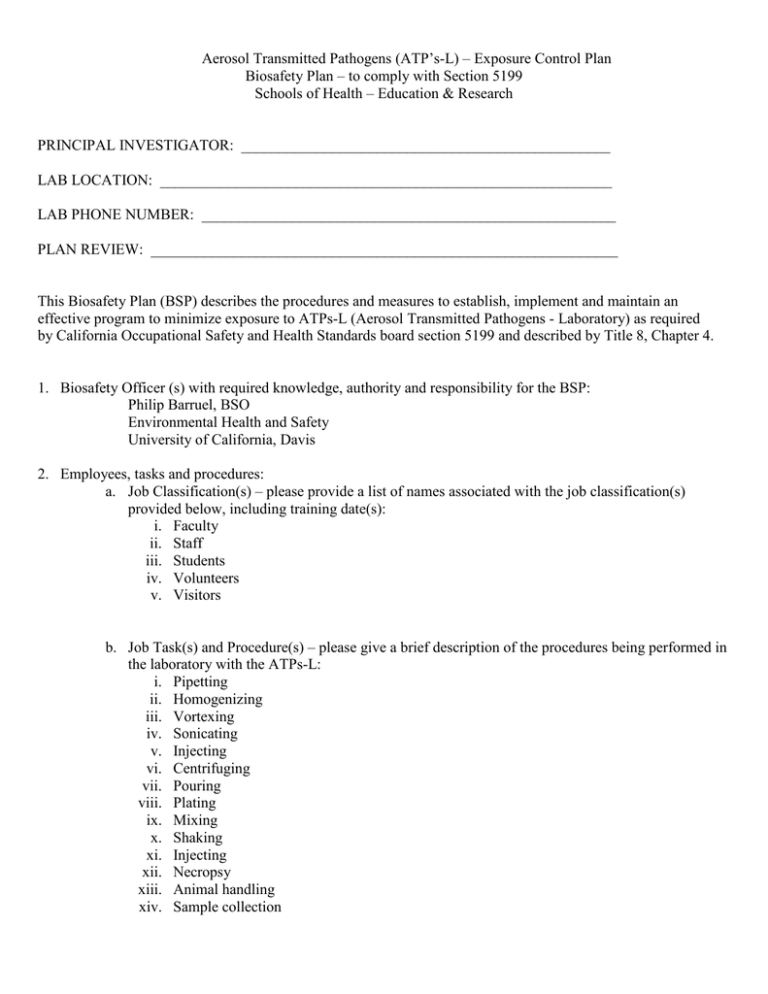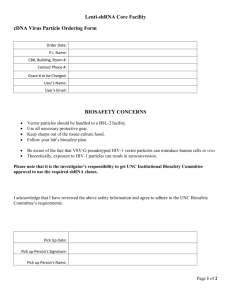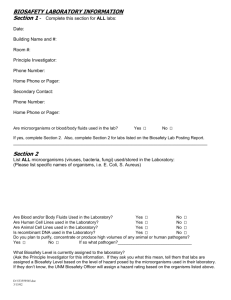Aerosol Transmitted Pathogens (ATP’s-L) – Exposure Control Plan
advertisement

Aerosol Transmitted Pathogens (ATP’s-L) – Exposure Control Plan Biosafety Plan – to comply with Section 5199 Schools of Health – Education & Research PRINCIPAL INVESTIGATOR: _________________________________________________ LAB LOCATION: ____________________________________________________________ LAB PHONE NUMBER: _______________________________________________________ PLAN REVIEW: ______________________________________________________________ This Biosafety Plan (BSP) describes the procedures and measures to establish, implement and maintain an effective program to minimize exposure to ATPs-L (Aerosol Transmitted Pathogens - Laboratory) as required by California Occupational Safety and Health Standards board section 5199 and described by Title 8, Chapter 4. 1. Biosafety Officer (s) with required knowledge, authority and responsibility for the BSP: Philip Barruel, BSO Environmental Health and Safety University of California, Davis 2. Employees, tasks and procedures: a. Job Classification(s) – please provide a list of names associated with the job classification(s) provided below, including training date(s): i. Faculty ii. Staff iii. Students iv. Volunteers v. Visitors b. Job Task(s) and Procedure(s) – please give a brief description of the procedures being performed in the laboratory with the ATPs-L: i. Pipetting ii. Homogenizing iii. Vortexing iv. Sonicating v. Injecting vi. Centrifuging vii. Pouring viii. Plating ix. Mixing x. Shaking xi. Injecting xii. Necropsy xiii. Animal handling xiv. Sample collection 3. ATPs-L known or reasonably expected to be present in the laboratory: Please refer to appendix D and ID the ATPs-L in the laboratory. 4. Safe handling practices: a. Practices for handling samples and specimens will follow the standards described in the BMBL5 for BSL3. i. Location of where work will be performed. ii. Mechanical pipetting devices are to be used at all times. iii. Procedures are to be carefully performed to minimize splashes or aerosols. iv. Hands will be washed after removing gloves and before leaving the laboratory. v. Razor blades, scalpels, and hypodermic needles (sharps) and other sharp instruments are limited to use only when there is no alternative. These include vaccination, administration of anesthesia, collection of blood or other fluid samples, infection, and necropsy. vi. Work surfaces will be decontaminated at least once per day with 70% ethanol. Following any spill of the ATPs-L, the surface will be decontaminated with 0.5% sodium hypochlorite (10% bleach). vii. All cultures, stocks, and other regulated waste, will be decontaminated before disposal by addition of 10% bleach. viii. Plasticware will be substituted for glassware whenever possible. ix. All high risk operations will be conducted with two knowledgeable individuals present. x. Culture flasks will only be opened while contained in the BSC. b. Prohibited practices: i. There will be no eating drinking, smoking, handling contact lenses, or applying cosmetics in laboratory room(s) _______________ at any time. ii. Mouth pipetting is prohibited. iii. Do not place your head into the BSC. iv. Cultures and other samples will not be sniffed 5. Engineering controls: a. All procedures involving the manipulation of infectious materials will be conducted within a BSC other physical containment device (i.e. tubes for centrifugation will be placed into sealed cups with an o-ring). b. Laboratory doors are self-closing. Access to the laboratory is restricted to entry by a series of two self-closing doors. For the BSL-3 suites, a clothing change room (anteroom) is included in the passageway between the two self-closing doors. c. The laboratory must be designed so that it can be easily cleaned and decontaminated. Carpets and rugs are not permitted. Seams, floors, walls, and ceiling surfaces should be sealed. Spaces around doors and ventilation 6. Personal protective equipment (PPE): a. Closed front gown, gloves, respirator, and shoe coverings must be made available and based on laboratory SOP’s, will be worn in the laboratory rooms when working with the sample(s) and/or sample collection. b. All individuals using a respirator must participate in the campus respirator program. c. Eye protection must be worn if there is a possibility of a splash to the eye. d. Additional protective equipment may also be required based on a risk assessment of the characteristics of the agent and the containment system. 7. Decontamination and disinfection procedures: a. Agent: i. May be killed or inactivated by exposure for 30 minutes to 0.5% sodium hypochlorite and 70% ethanol. These will be used to disinfect and decontaminate surfaces and small areas. ii. Formaldehyde, paraformaldehyde, gluteraldehyde, and hydrogen peroxide vapor can also be used to kill the fungus. These may be used to decontaminate larger areas and/or the entire laboratory. b. Procedure: i. Work spaces will be decontaminated upon completion of work by the application of freshly prepared 0.5% sodium hypochlorite or 70% ethanol. ii. Areas decontaminated with sodium hypochlorite will be rinsed with water to remove sodium hypochlorite residue. iii. Bench surfaces, centrifuge, shakers, and door handles will be disinfected weekly. iv. Floors will be mopped monthly. 8. All incoming packages containing ATPs-L will be treated as containing the virulent or wild-type pathogen until verified at the laboratory that a pathogen has been deactivated or attenuated. a. Unopened package surface inspected for integrity, wiped down with 0.5% sodium hypochlorite (10% bleach). b. Package opened inside a BSC to ensure worker protection. 9. Annual laboratory inspection and biosafety audit The Environmental Health and Safety Biosafety Office will conduct an annual inspection of the laboratory, audit training and other required documents. 10. Emergency procedures: a. Spills within the laboratory facility: i. If agent is spilled inside the containment devise, work should immediately cease and the spill cleaned up. Check gown and if contaminated, remove and replace with a clean gown. Replace gloves if contaminated and add second pair of gloves. Cover the spell with paper towel or other absorbent material and pour freshly prepared 10% bleach onto the spill. Pour only enough to cover the spill. Avoid “expanding” the spill. Allow 30 minutes of contact time. Place all material into the red biohazard bag and treat as Medical Waste. ii. If agent is spilled outside of containment, cease work immediately. Attempts to clean spill should take into consideration the infectious nature for the organism as well as the production of aerosolized material. Carefully cover spilled material with paper towel or other absorbent material. Pour 10% bleach onto towel. Do not use spray bottle as it may produce aerosol. Allow 30 minutes contact time. If material enters the floor drain, pour undiluted bleach into the drain. Clean spill from outside to center. Rinse area with water to remove bleach residue. Place all used material into red biohazard bag and treat as Medical waste. Notify campus biosafety officer. If the spill is large or cannot be readily handled by existing personnel, the lab should be evacuated and emergency responders notified by calling 911. iii. Personal decontamination - Following an incident, an evaluation should be performed to determine if material (biohazard and/or non-biohazard) may have contaminated skin and/or clothing. iv. Biohazard contaminant: 1. Gloves. Remove contaminated gloves and dispose of as medical waste. 2. Lab Gown and/or clothing. Remove contaminated lab gown and any contaminated or potentially contaminated articles of clothing. Clothing should be wetted gently b. c. d. e. with soapy or detergent-containing water in such a way to minimize dislodging and aerosolizing any fungal cells. Clothing may be put into a bag and autoclaved or into a plastic tub and treated by one of the following procedures below: a. Heat at 60 degrees C. or higher for 30 minutes. b. Cover and soak for 30 minutes with hypochlorite beach (1:10 dilution of the usual 5% hypochlorite). c. Cover and soak for 1 hr with 70% alcohol. d. Clothing may be laundered in soapy or detergent-containing water following any of the above procedures. e. Tyvek suits are available in the laboratory for re-gowning. f. Skin - wash contaminated skin with betadine (7.5% povidone-iodine). After developing lather, skin should be scrubbed thoroughly for a minimum of 15 minutes. Rinse with water. 1 L of 10% bleach should be poured down any sink used during washing. v. Non-biohazard contaminant: 1. Gloves. Remove contaminated gloves and dispose of as medical waste taking into consideration the contaminating material. 2. Lab Gown and/or clothing. Remove contaminated clothing. Clothing should be decontaminated taking into consideration the contaminating material. 3. Skin - wash contaminated with skin with soap and water for a minimum of 15 minutes taking into consideration the contaminating material. Use a shower if it is available within the laboratory suite. Emergency evacuation i. If notified to evacuate while working with select agent, cease work immediately. ii. Close all containers and secure agent. iii. Exit area according to planned evacuation route (see attached map). iv. Proceed to the designated meeting area for a roll call. Loss of negative pressure in the laboratory suite: i. If no work is being completed in room and the alarm sounds indicating loss of negative pressure in inner rooms, call EH&S (752-1493), campus biosafety officer and/or 911. Do not enter rooms. ii. If working in the laboratory suite when the alarm sounds, cease work immediately, close any open containers, secure agent (i.e. place in a locked cabinet or secure with some other locked means), and exit area. Do not re-enter area until instructed. Loss of negative pressure in biosafety cabinet or glove boxes: i. If pressure drops below 50 on magnehelix gauge on the glove box or below that indicated on the certification sticker on the biosafety cabinet, immediately stop work, close any open containers, and secure select agent. Evacuate room. ii. Inform PI and/or Laboratory Manager, call EH&S and campus biosafety officer. Power Failure: i. If there is a loss of power while working in biosafety cabinet, stop work immediately, close any open containers, secure select agent, and evacuate room. The biosafety cabinet and fans have emergency power backup. Flashlights are also located in the rooms. ii. If material is spilled during a power failure, cover and start decontamination if possible. Evacuate and call EH&S, campus biosafety officer, and/or 911. iii. If decontamination of the spill is not possible or if it would create a greater hazard, immediately evacuate and call EH&S, campus biosafety officer, and/or 911. iv. If there is a power failure for an extended period such that refrigerated material may be lost, dry ice or ice packs can be placed in refrigerator/freezer and will help maintain cold for short periods. f. Earthquake: i. Stop activity, close open containers, and secure agent. ii. If in the laboratory suite, exit the room, remove PPE, and move to anteroom/closest room doorframe. iii. Evacuate as soon as temblor stops. iv. Call EH&S, campus biosafety officer, and/or 911 if spill or damage is known. g. Bomb Threat: If notified of a bomb threat, cease work immediately, secure agent, and evacuate as indicated. If the recipient of a bomb threat (by phone), immediately record details of call and threat and call 911. Cease work immediately, secure agent, and evacuate as indicated. Call campus biosafety officer. a. Explosions: If an explosion is noticed outside of the suite, cease work immediately, secure agent, and exit room. Evacuate as directed. If working with a Select Agent/Toxin, call campus RO and 911. If explosion is experienced within suite, cease work and secure agent. Evacuate room. Call 911 and campus RO. b. Severe weather: i. Water/flood: Depending on where the laboratory suite is located will determine whether flooding due to excess rain should affect the laboratory. Water may however enter the laboratory through the ceiling or through a water leak in the building. If water is noted leaking into the laboratory, secure and/or relocate agent such that it will not be damaged or released. Call campus biosafety officer and campus facilities. ii. Tornado: Occasionally funnel clouds are noticed in the area although they rarely touch down. In the event that a tornado warning is given, cease work, and secure agent. If Tupper Hall is in the path of a downed tornado, move to rooms away from windows preferably on 1st floor. After emergency has passed, if allowed, return and evaluate damage to suite. Notify campus biosafety officer and 911 if damage is noted. iii. Severe thunderstorms. Although severe thunderstorms should not cause any physical damage to the laboratory, it is possible that a loss of power may be experienced. If power is lost, stop work, secure agent and evacuate.I iv. Hurricane. If a hurricane warning is given stop work and secure agent. After hurricane and/or warning has passed, if allowed return and evaluate damage to the suite. Notify campus RO and call 911 if damage is noted. b. Fire In the event of a fire, cease work, secure agent, and evacuate as directed. If fire originated in suite, call 911. If fire is small, attempt to extinguish. The nearest extinguisher is located outside the entrance to 3180. Call campus biosafety officer. After emergency, evaluate agent for potential loss and perform inventory check. 11. Medical treatment and Services: a. Equipment for rescue and medical duties: The following are available for employee use while performing rescue and medical duties: i. Extra gloves ii. Closed front gowns and shoe covers iii. Respirators (employee must have received prior fit and training) iv. Tyvek coveralls v. First Aid Kit vi. Emergency eye wash vii. Chemical spill kits viii. Fire extinguisher, hall near room(s) ____________________. b. Procedures for employees performing medical or rescue duties: i. In the case of a medical emergency within the suite, call 911. ii. If the injured individual is ambulatory, have the person remove PPE (may need assistance) and move to the anteroom. If the individual is unconscious do not move the person. Call the main research lab _____________________ for assistance if necessary. iii. Administer first aid as appropriate and assist emergency responders as directed. If the individual cannot be moved from the lab, assist emergency responders in proper gowning to enter the laboratory. If it is safe to leave the injured individual, go and assist emergency responders with entrance to the facility/suite. iv. Remain within laboratory while emergency personnel are present. v. If it appears that the agent has been released (spilled), begin decontamination of the area. vi. Injured individuals should immediately be taken to Occupational Health Services (or Student Health if a student). After normal business hours, go to Sutter Hospital Emergency. c. Exposure Immediately following a known or possible exposure, the employee will be evaluated by the medical personnel at Occupational Health Services (or Student Health if a student). An initial serum sample will be collected for testing. The individual will be advised of the symptoms of coccidioidomycosis and instructed to report if any of these are observed. If no symptoms are observed, a second serum sample will be collected 4 weeks following the exposure. d. Serum bank/vaccinations Serum banking and vaccinations will be determined as part of the medical surveillance program for Occupational Safety. 12. Initial and Refresher Training: All employees will receive initial training and annual refresher training with regard to ATPs-L BSP. 13. Employee evaluation of BSP in their work area: Employees will evaluate the ATPs-L BSP during the refresher training. Necessary changes will be made to the BSP.




